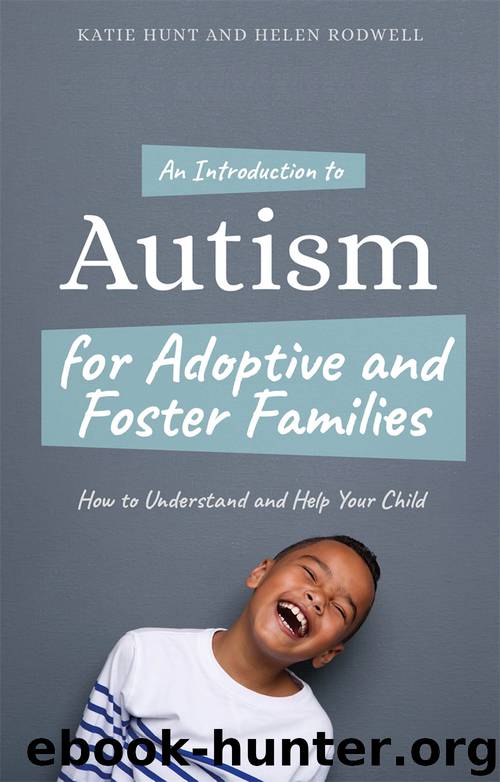An Introduction to Autism for Adoptive and Foster Families by Katie Hunt

Author:Katie Hunt
Language: eng
Format: epub
ISBN: 9781784507596
Publisher: Jessica Kingsley Publishers
Published: 2018-08-28T16:00:00+00:00
Going home at the end of the day
We are not saying that all children with autism will find all of these transition points difficult, but many will struggle with some of them. Many of the parents and children with autism that we have worked with over the years have found the end of the day very difficult and have often struggled to understand why, especially as they have felt that it should be something that an autistic child would look forward to.
There are a few reasons why children with autism might find the end of the school day tricky.
• The change from the structured school setting (which many children with autism find reassuring) to the lack of structure involved in going home may cause anxiety.
• The crush of bodies in the cloakroom at the very end of the day can cause a child with autism to feel overwhelmed by sensory demands.
• For some children, going home provides a release from all the things they have been keeping a lid on all day and their difficulties with emotional regulation mean that this spills over into difficulties with behaviour at the very point when they return to their parent.
Having a Teacher and a school that understands why these ‘small’ transitions are difficult is going to be crucial in helping your child to manage throughout the day. We don’t want any parent to think that their autistic child is having a dreadful time at school day after day – it is unlikely that this is the case – but there will be things that cause anxiety for her around transitions. The understanding that you and the important adults around your child can give her is key.
We’ve talked before about assessment (what is actually going on), formulation (what it might mean: the why), intervention (what to do about it) and looking behind the behaviour that is right in front of you. This is so important when thinking about what might be going on for a child with autism when she is struggling with behaviour in school. In our experience, the most common problem is anxiety that is related to a transition (including the anxiety that comes from sensory difficulties). This is the area where really small changes can make such a positive difference. The challenge, though, is recognising what is going on and when, i.e. which transition is causing the distress.
It can be helpful to ask the following questions to try to narrow it down.
• When in the school day do problems tend to happen?
• Is your child generally more unsettled than people would expect when coming back into class after a break?
Are there simple things that can be done to make a big difference? Remember that we have already talked about how environmental changes can make a huge positive difference and how understanding what is difficult, why and when can often suggest straightforward changes.
We’ll talk about practical strategies further on, but, in our experience, it can be very small changes that make a very big difference.
Download
This site does not store any files on its server. We only index and link to content provided by other sites. Please contact the content providers to delete copyright contents if any and email us, we'll remove relevant links or contents immediately.
| Administration & Medicine Economics | Allied Health Professions |
| Basic Sciences | Dentistry |
| History | Medical Informatics |
| Medicine | Nursing |
| Pharmacology | Psychology |
| Research | Veterinary Medicine |
Periodization Training for Sports by Tudor Bompa(7928)
Why We Sleep: Unlocking the Power of Sleep and Dreams by Matthew Walker(6362)
Paper Towns by Green John(4804)
The Immortal Life of Henrietta Lacks by Rebecca Skloot(4261)
The Sports Rules Book by Human Kinetics(4079)
Dynamic Alignment Through Imagery by Eric Franklin(3923)
ACSM's Complete Guide to Fitness & Health by ACSM(3826)
Kaplan MCAT Organic Chemistry Review: Created for MCAT 2015 (Kaplan Test Prep) by Kaplan(3803)
Introduction to Kinesiology by Shirl J. Hoffman(3627)
Livewired by David Eagleman(3535)
The River of Consciousness by Oliver Sacks(3420)
The Death of the Heart by Elizabeth Bowen(3342)
Alchemy and Alchemists by C. J. S. Thompson(3298)
Descartes' Error by Antonio Damasio(3167)
Bad Pharma by Ben Goldacre(3100)
The Emperor of All Maladies: A Biography of Cancer by Siddhartha Mukherjee(2932)
The Gene: An Intimate History by Siddhartha Mukherjee(2929)
The Fate of Rome: Climate, Disease, and the End of an Empire (The Princeton History of the Ancient World) by Kyle Harper(2876)
Kaplan MCAT Behavioral Sciences Review: Created for MCAT 2015 (Kaplan Test Prep) by Kaplan(2817)
